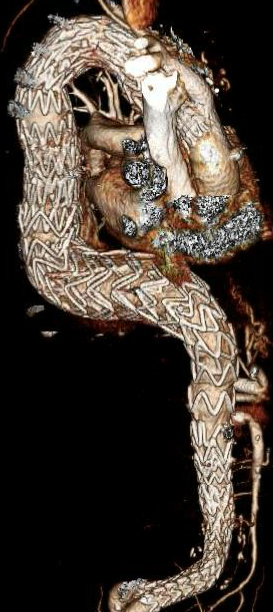Complete Aortic Stenting From Zone 0 To The Iliac Arteries
Galimat Khaidakova, MD, William D. Jordan, Jr, Yazan Duwayri, Bradley G. Leshnower.
Emory, Atlanta, GA, USA.
Demographics Multiple aneurysms occur in as many as 12.6% of patients with abdominal aortic aneurysmal disease1 and up to 29% of patients presenting with thoracic aortic aneurysms2. Rupture of a second aneurysm follows cardiac events as a leading cause of death in this patient population3. History Here we present the case of a 70 yo female with a complex vascular history that included EVAR in in 2011, TEVAR with carotid subclavian bypass in 2014 (complicated by spinal ischemia resulting in bowel and bladder incontinence), followed by embolization of the left subclavian artery for endoleak in 2017. She underwent CABG in 2018. In 2019 she presented with hypertensive crisis and abdominal pain radiating to the back with imaging concerning for endoleak in the abdominal and thoracic segments with a maximum aortic diameter of 7 cm at the arch, 6.5 cm at the aortic hiatus, and 5cm in the infrarenal segment. Treatment The patient underwent a staged procedure with right to left common carotid artery bypass, and zone 0 TEVAR with right innominate snorkel (her 3rd aortic operation), complicated by stroke which left no residual deficit. This was followed by a four vessel fenestrated endograft with stenting of the Celiac, SMA, and bilateral renal (4th operation), staged with bilateral iliac graft extensions to correct type 1b endoleaks (5th operation). Discussion Surgical treatment in patients with multiple aneurysms carries a high level of morbidity, with one study showing 10.4% and 33.3% procedural mortality during second and third operations, respectively. Since the popularization of endovascular aortic aneurysm repair, the numbers of open repair for AAA have dropped by 80% in the last 10 years4, however, we are sure to face new challenges in endovascular repair that will require increasingly creative solutions. This patient underwent stenting of 63cm of aorta, using 3 types of endografts, resulting in complete coverage of her ascending, thoracic and abdominal aorta. With appropriate staging, we show that this can be performed with acceptable morbidity. 
Back to 2020 Abstracts
